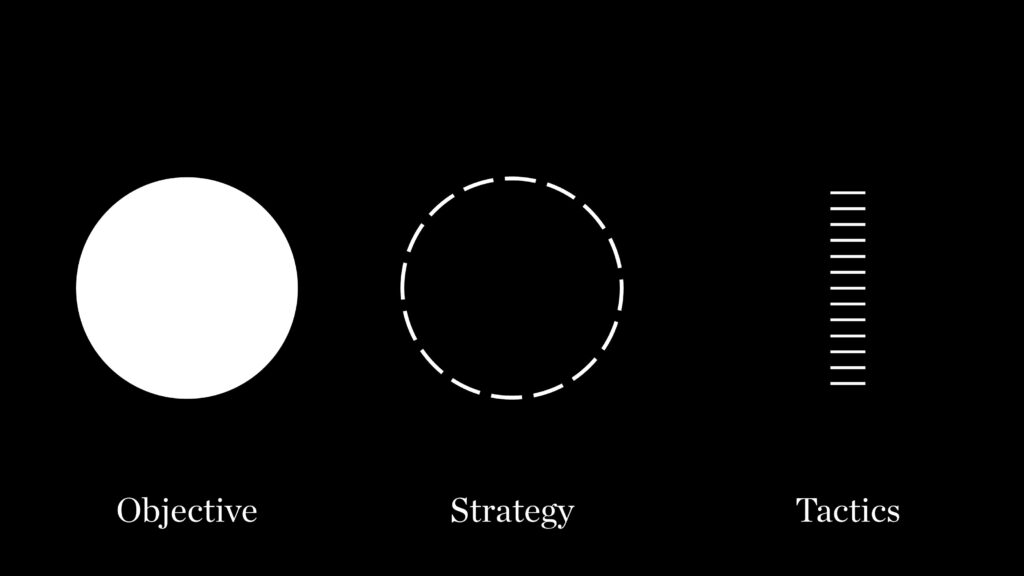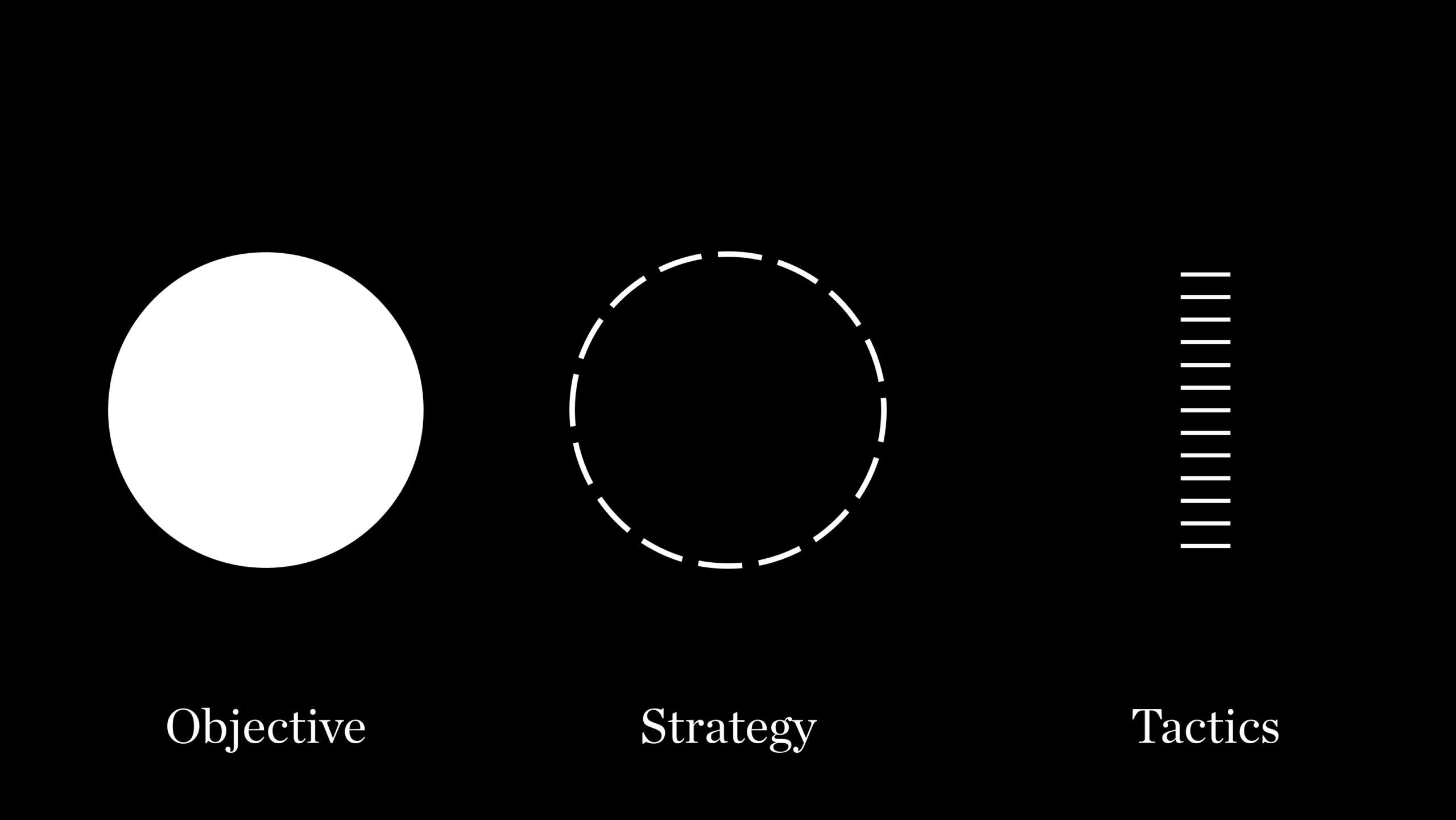Article last updated on January 10, 2022
Regardless of whether you’re drafting a communications strategy, a marketing plan, or a company strategy, you’re surely aware that a variety of components are necessary.
Before you begin your marketing campaign, you need to know who your target is, what your core messages are, and your budget, timeframe, and assessment methods.
As well as the core of every effective plan: your objectives, strategy, and tactics.

The objective is the result you want to achieve with your campaign. The strategy is how you will get there. And the tactics are how you’ll do so.
This article will look at each of these three elements in more detail and explain why they’re important for any successful business strategy.
Let’s start with the objective first.
Objective
You can think of the objective as the “why” behind all your other decisions.
It’s often referred to as the “end game,” but that doesn’t necessarily mean you’ll be able to see the results immediately after launching your campaign.
Why did you launch your campaign? Was it because you had a new product or service to offer? Or was it because you wanted to increase sales? Whatever the reason, your objective is the ultimate goal of your campaign.
The most common reasons people create campaigns are to drive traffic to their website, promote their brand, sell products, generate leads, grow social media followers, etc.
Whatever your reason for creating a campaign, there’s one thing you should never forget: your objective is the result you want to achieve.
So, before you start planning any other elements of your campaign, you need to know what this is.
Your objective is the reason you launched your campaign in the first place.
It’s the reason you created a website, wrote content, designed graphics, hired staff, built relationships, etc.
Once you’ve set your objective, you can move on to thinking about how you’ll get there.
This is where your strategy comes into play.
Strategy
A good strategy is a road map to help you reach your objective.
It outlines exactly what you intend to accomplish, when you intend to achieve it, and how you plan to do it.
A great strategy will provide you with an overview of all the steps involved in reaching this objective.
It will help you understand where you’re going and what you need to do to get there.
It will tell you who you’ll need to work with and what resources to use.
It will show you how much time and effort it will take to complete each task. And it will give you a clear idea of how long it will take to reach your objective.
If you don’t have a good strategy yet, now is the time to put together a simple document outlining what you intend to do.
You could call it a mission statement, a business plan, a marketing plan, or whatever suits your needs. But make sure it clearly states your objectives and shows you how you plan to get there.
Developing a solid strategy is a lot of work, but it is essential to achieve your objectives.
My Clarity Blueprint focuses only on that, and I can proudly say it brings results for my clients every time.
Sometimes it takes more time, but it works, and more importantly, it helps online businesses stop guessing what they must do to grow their business.
Strategies shouldn’t be merely jotted down and then forgotten about.
Tactics
Finally, we come to your tactics. These are the specific ways you’ll go about achieving your objective.
They may involve hiring someone to write copy, designing a logo, building a website, writing articles, posting videos, etc.
Regardless of which tactics you choose, they should always be aligned with your overall strategy.
For example, if you aim to sell more products, your tactics should focus on generating more leads, closing deals, increasing conversions, etc.
In short, your tactics should support your strategy.
They shouldn’t just be random ideas thrown into a list.
Now, once you’ve got your strategy and tactics sorted out, you’re ready to start planning your campaign.
But before you begin, it’s important to think about some questions.
What are you hoping to achieve by launching this campaign?
Why did you decide to launch it?
What’s your goal?
These are important questions because they’ll help you determine whether your campaign is worth doing.
And if you find yourself asking these questions, chances are you already know the answer.
You probably decided to create this campaign because you wanted something better.
Or maybe you’re trying to increase sales or build brand awareness.
Whatever the case may be, you want to be able to explain why you launched this campaign so that people can see its value.
Objectives, Strategy, and Tactics Combined
When you combine objectives, strategy, and tactics, you end up with a powerful combination.
This combination gives you a clear picture of what you need to do, how you need to do it, when you need to do it, and why you need to do it.
This means you can easily identify gaps in your current approach and quickly correct them.
The best thing is that all three components (objectives, strategy, and tactics) are interrelated.
So, for instance, if you set an objective to generate $10,000 per month in revenue, you’d also need to develop a strategy and tactics to accomplish this.
If you didn’t, you wouldn’t know where to start.
So, before you launch your campaign, ask yourself these three questions:
What are my objectives?
How will I achieve those objectives?
What are my strategies?
How will I implement those strategies?
Once you have these answers, you’ll be well on your way to creating a successful campaign.
What’s the difference between strategy vs tactics?
Strategy refers to long term goals, while tactics are short-term actions. For example, if you want to be successful at work, you need to develop a strategy to achieve this goal. Tactics are the steps you take to get there.
Objectives, Strategy, and Tactics Examples
Here are examples of objectives, strategies, and tactics from very successful campaigns.
Personal example:
| Objective | I’d like to lose 40 pounds by the end of the year. |
| Strategy | I will do more exercise and eat better. |
| Tactic | I plan to run every morning and eat salads five days a week. |
Business example:
| Objective | I want to get an 80% increase in sales by the end of 2022. |
| Strategy | I will focus on content marketing and brand credibility to improve short-and long-term sales. |
| Tactic | I will have a system to produce 4–7 pieces of informational content per day, solving problems for my potential customers. |
Personal example:
| Objective | I’d like to be more productive and work 2 hours less per day so that I can be with my kids more in the next six months. |
| Strategy | I will eliminate all distractions and prioritize what is important. |
| Tactic | I plan to use software to block my distractions and review my tasks before and after work. |
Business example:
| Objective | I want to increase traffic to my website by 5X by the end of 2022. |
| Strategy | I will focus on content production. |
| Tactic | I will have a system and a team that will produce 15 pieces of content every week. |
Important Notes
I want to add some notes on objectives, strategy, and tactics.
- Don’t confuse objectives with goals. Goals are things you want to achieve, while objectives are specific actions you need to take to achieve your goals.
- Don’t confuse objectives, strategy, and tactical plans. An objective is something you want to achieve. A strategy is how you’ll go about achieving it. A tactic is a specific action you need to take to make it happen.
- Have clearly defined objectives, strategies, and tactics. SMART goals are the foundation for all future decision-making since they’re specific, measurable, attainable, relevant, and time-bound.
- Whenever in doubt, always ask yourself, “Does this assist me attain my objective?”
- A tactic is a short-term step towards achieving your objective.
- Key performance indicators (KPIs) are metrics used to measure the success of your strategy. They help you track progress against your objectives.
- Strategy without tactics isn’t effective. Tasks must be completed in order to implement your strategy.
- Tactics don’t create strategy. You need to have a clear vision of where you want to go, and then you need to put together a detailed plan to get there.
- Tactics without strategy aren’t effective. Your strategy should include a set of tactics to execute them.
- Tactics without objectives aren’t effective. Without a clear objective, you won’t know whether or not you’ve achieved anything.
- A good and focused marketing strategy requires strategic planning and business goals. Objectives are one step above marketing strategy, and marketing tactics are one step below marketing strategy, which is usually a form of marketing mix approach.
Conclusion
I hope this article has helped you understand the importance of having a clear strategy and tactical plan.
Remember that you won’t know where to start or what steps to take without them.


